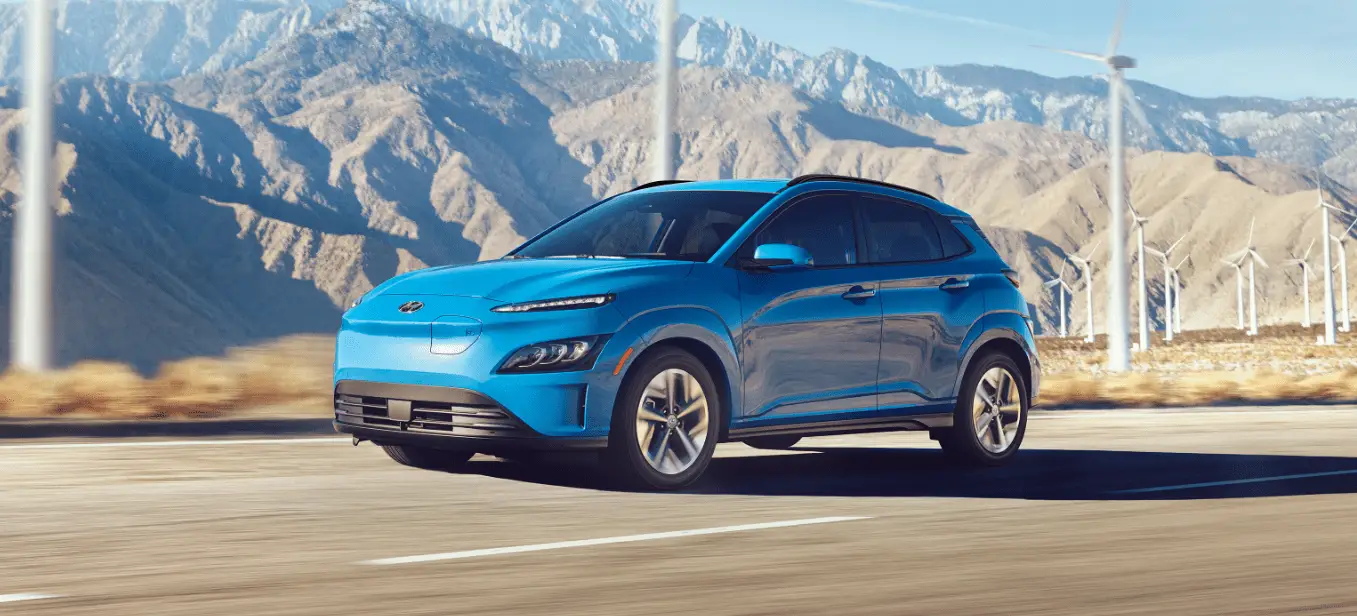Hyundai Kona-EV 2023 Cruise Control (CC)
The 2023 Hyundai Kona-EV has a new improved Cruise and Smart Cruise Control System that changes how safe and easy it is to drive. A traditional Cruise Control feature is built into this innovative system. It lets drivers set and keep a certain speed effortlessly, making long trips more comfortable and saving gas. That’s not all, though. The Smart Cruise Control, which is also called Adaptive Cruise Control (ACC), is the next generation of cruise control. It uses advanced radar and camera technology to find vehicles ahead and change the Kona-EV’s speed to keep a safe distance. This system makes driving smoother, safer, and more relaxing, whether you’re on the highway or in heavy traffic. It shows Hyundai’s dedication to combining cutting-edge technology with environmentally friendly electric mobility.
2023 Hyundai Santa Fe Specs, Price, Features, Milage (Brochure)
Cruise Control (CC)
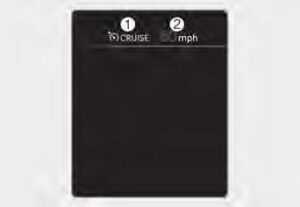
- Cruise indicator
- Set speed
Cruise Control will allow you to drive at speeds above 20 mph (30 km/h) without depressing the accelerator pedal.
Cruise Control Operation
To set speed
- Accelerate to the desired speed, which must be more than 20 mph (30 km/h)

- Press the Driving Assist button at the desired speed. The set speed and Cruise ( ) indicator will illuminate the cluster.
- Release the accelerator pedal.
Vehicle speed will maintain the set speed even when the accelerator pedal is not depressed.
Information
On a steep slope, the vehicle may slightly slow down or speed up while driving uphill or downhill.
Increasing set speed
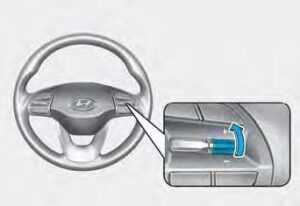
- Push the + switch up and release it immediately. The set speed will increase by 1 mph (1 km/h) each time the switch is operated in this manner.
- Push the + switch up and hold it while monitoring the set speed on the cluster. The set speed will increase to the nearest multiple of five in mph (multiple of ten in km/h) at first, and then increase by 5 mph (10 km/h) each time the switch is operated in this manner.
Release the switch when the desired speed is shown and the vehicle will accelerate to that speed.
Decreasing set speed
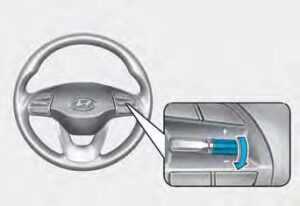
- Push the – switch down and release it immediately. The set speed will decrease by 1 mph (1 km/h) each time the switch is operated in this manner.
- Push the – switch down and hold it while monitoring the set speed on the cluster. The set speed will decrease to the nearest multiple of five in mph (multiple of ten in km/h) at first, and then decrease by 5 mph (10 km/h) each time the switch is operated in this manner.
Release the switch at the speed you want to maintain.
Temporarily cancelling Cruise Control
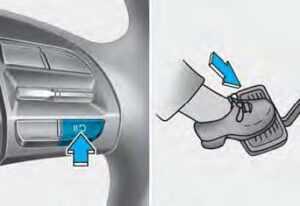
Cruise Control will be paused when:
- Depressing the brake pedal.
- Pressing the button.
- Shifting the gear to N (Neutral).
- Decreasing vehicle speed to less than approximately 20 mph (30 km/h).
- ESC (Electronic Stability Control) is operating.
- Downshifting to 2nd gear when in Manual Shift mode.
The set speed will turn off but the Cruise ( ) indicator will stay on.
Resuming Cruise Control
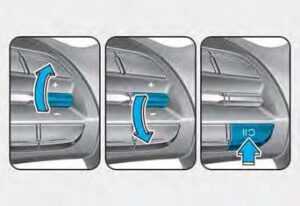
Push the +, – switch or button.
If you push the + switch up or – switch down, the vehicle speed will be set to the current speed on the cluster. If you Press the button, the vehicle speed will resume to the preset speed.
Vehicle speed must be above 20 mph (30 km/h) for the function to resume.
Turning off the Cruise Control

Press the Driving Assist button to turn Cruise Control off. The Cruise ( indicator will go off.
Always press the Driving Assist button to turn Cruise Control off when not in use.
Information
If your vehicle is equipped with Manual Speed Limit Assist, press and hold the Driving Assist button to turn off Cruise Control. However, Manual Speed Limit Assist will turn on.
warning
Take the following precautions when using Cruise Control:
- Always set the vehicle speed to the speed limit in your area.
- Keep Cruise Control off when the function is not in use, to avoid inadvertently setting a speed. Check that the Cruise ( ) indicator is off.
- Cruise Control does not substitute for proper and safe driving. It is the responsibility of the driver to always drive safely and should always be aware of unexpected and sudden situations occurring.
- Always drive cautiously to prevent unexpected and sudden situations unexpected and sudden from occurring road conditions at all times.
- Do not use Cruise Control when it may be unsafe to keep the vehicle at a constant speed:
- When driving in heavy traffic, or when traffic conditions make it difficult to drive at a constant speed
- When driving on rainy, icy, or snow-covered roads
- When driving on hilly or windy roads
- When driving in windy areas
- When driving with a limited view (possibly due to bad weather, such as fog, snow, rain and sandstorms)
- Do not use Cruise Control when towing a trailer.
Smart Cruise Control (SCC)
Smart Cruise Control is designed to help detect the vehicle ahead and help maintain the desired speed and minimum distance between the vehicle ahead.
Overtaking Acceleration Assist
While Smart Cruise Control is operating, if the function judges that the driver is determined to overtake the vehicle in front, acceleration will be assisted.
Detecting sensor
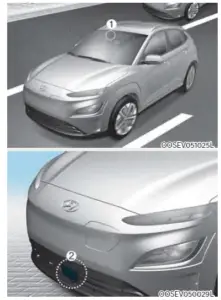 [1]: Front view camera, [2]: Front radar
[1]: Front view camera, [2]: Front radar
The front view camera and front radar are used as detecting sensors to help detect vehicles in front.
Refer to the picture above for the detailed location of the detecting sensor.
CAUTION
Always keep the front view camera and front radar in good condition to maintain the optimal performance of Smart Cruise Control.
For more details on the precautions of the front view camera and front radar, refer to the “Forward Collision-Avoidance Assist (FCA)” section in this chapter.
Smart Cruise Control Settings
Setting features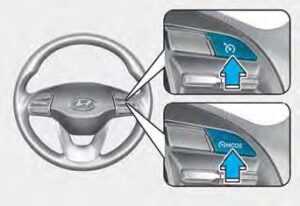
To turn on Smart Cruise Control
- Press the Driving Assist button to turn on Smart Cruise Control. The speed will be set to the current speed on the cluster.
- If there is no vehicle in front of you, the set speed will be maintained, but if there is a vehicle in front of you, the speed may decrease to maintain the distance to the vehicle ahead. If the vehicle ahead accelerates, your vehicle will travel at a steady cruising speed after accelerating to the set speed.
Information
- If your vehicle speed is between 0~20 mph (0~30 km/h) when you press the Driving Assist button, the Smart Cruise Control speed will be set to 0~20 mph (0~30 km/h).
- The Driving Assist button symbol may vary depending on your vehicle option.
 To set vehicle distance
To set vehicle distance
Each time the button is pressed, the headway changes as follows: Information
Information
- If you drive at 56 mph (90km/h), the distance is maintained as follows:
Distance 4 –
approximately 172 ft. (52.5 m)
Distance 3 –
approximately 130 ft. (40 m)
Distance 2 –
approximately 106 ft. (32.5 m)
Distance 1 –
approximately 82 ft. (25 m) - The distance is set to the last set distance when the vehicle is restarted, or when Smart Cruise Control was temporarily canceled.
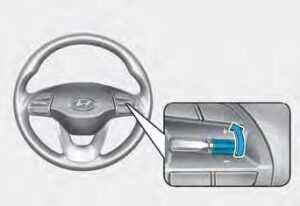 Increasing set speed
Increasing set speed
- Push the + switch up and release it immediately. The set speed will increase by 1 mph (1 km/h) each time the switch is operated in this manner.
- Push the + switch up and hold it while monitoring the set speed on the cluster. The set speed will increase by 5 mph or 10 km/h each time the switch is operated in this manner. Release the switch when the desired speed is shown, and the vehicle will accelerate to that speed. You can increase the set speed to 110 mph (180 km/h).
WARNING
Check the driving condition before using the + switch. Driving speed may sharply increase when you push up and hold the + switch.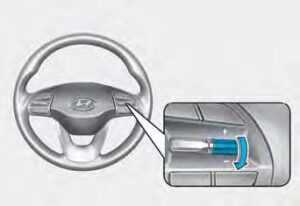 Decreasing set speed
Decreasing set speed
- Push the – switch down and release it immediately. The set speed will decrease by 1 mph (1 km/h) each time the switch is operated in this manner.
- Push the – switch down and hold it while monitoring the set speed on the cluster. The set speed will decrease by 5 mph or 10 km/h each time the switch is operated in this manner.
Release the switch at the speed you want to maintain. You can decrease the set speed to 20 mph (30 km/h).
 Temporarily cancelling Smart Cruise Control
Temporarily cancelling Smart Cruise Control
Press the switch or depress the brake pedal to temporarily cancel Smart Cruise Control. 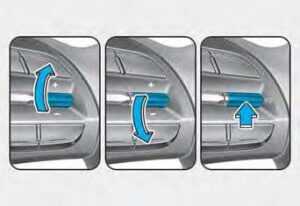 Resuming Smart Cruise Control
Resuming Smart Cruise Control
To resume Smart Cruise Control after the function was cancelled, operate the +, -, or switch.
If you push the + switch up or – switch down, the vehicle speed will be set to the current speed on the cluster.
If you press the switch, the vehicle speed will resume to the preset speed.
WARNING
Check the driving condition before using the switch. Driving speed may sharply increase or decrease when you press the switch.
 Turning off Smart Cruise Control
Turning off Smart Cruise Control
Press the Driving Assist button to turn Smart Cruise Control system off.
 Smart Cruise Reaction
Smart Cruise Reaction
With the vehicle on, select ‘Driver Assistance Smart Cruise Reaction’ from the Settings menu to select the sensitivity of vehicle speed when following the front vehicle to maintain the set distance. Warning Volume
Warning Volume
With the vehicle on, select ‘Driver Assistance > Warning volume’ from the Settings menu to change the Warninng Volume High, ‘Medium’ or “Low’ for Smart Cruise Control. If you change the Warning Volume, the warning volume of other Driver Assistance systems may change.
information
If the vehicle is restarted, Warning Volume will maintain the last setting.
2023 Hyundai Santa Fe Specs, Price, Features, Milage (Brochure)
Smart Cruise Control Operation
Operating conditions
Basic function
Smart Cruise Control will operate when the following conditions are satisfied.
- The gear is in D (Drive)
- The driver’s door is closed
- EPB (Electronic Parking Brake) is not applied
- Your vehicle speed is within the operating speed range
- 5-110 mph (10-180 km/h) : when there is no vehicle in front
- 0-110 mph (0-180 km/h) : when there is a vehicle in front
- ESC (Electronic Stability Control) or
- ABS (Anti-Lock Braking System) is on
- ESC (Electronic Stability Control) or ABS (Anti-Lock Braking System) is not controlling the vehicle
- Vehicle RPM is not in the red zone
- Forward Collision-Avoidance Assist brake control is not operating
Information
When stopped behind another vehicle, the driver can turn on Smart Cruise Control while the brake pedal is depressed.
Overtaking Acceleration Assist
Overtaking Acceleration Assist will operate when the turn signal indicator is turned on to the left (left-hand drive) or turned on to the right (right-hand drive) while Smart Cruise Control is operating, and the following conditions are satisfied:
- Your vehicle speed is above 40 mph (60 km/h)
- The hazard warning flasher is off
- A vehicle is detected in front of your vehicle
- Deceleration is not needed to maintain distance from the vehicle in front
WARNING
- When the turn signal indicator is turned on to the left (left-hand drive) or turned on to the right (right-hand drive) while there is a vehicle ahead, the vehicle may accelerate temporarily. Pay attention to the road conditions at all times.
- Regardless of your state’s driving direction, Overtaking Acceleration Assist will operate when the conditions are satisfied. When using the function in states with different driving directions, always check the road conditions at all times.
Smart Cruise Control Display and Control
Basic function
You can see the status of the Smart Cruise Control operation in the Driving Assist view on the cluster. Refer to “View Modes” section in chapter 4.
Smart Cruise Control will be displayed as below depending on the status of the function.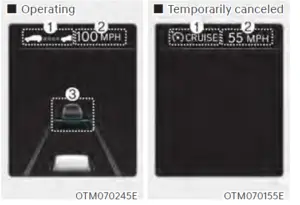
- When operating
- Whether there is a vehicle ahead and the selected distance level.
- Set speed.
- Whether there is a vehicle ahead and the target headway are displayed.
- When temporarily cancelled
- indicator.
- The previous set speed is shaded.
Information
- The distance of the front vehicle on the cluster is displayed according to the actual distance between your vehicle and the vehicle ahead.
- The target distance may vary according to the vehicle speed and the set distance level. If the vehicle speed is low, even though the vehicle distance have changed, the change of the target vehicle distance may be small.
To temporarily accelerate
If you want to speed up temporarily when Smart Cruise Control is on, depress the accelerator pedal. While the speed is increasing, the set speed, distance level and target distance will blink on the cluster. However, if the accelerator pedal is depressed insufficiently, the vehicle may decelerate.
WARNING
Be careful when accelerating temporarily, because the speed and distance is not controlled automatically even if there is a vehicle in front of you.
Smart Cruise Control temporarily canceled
 Smart Cruise Control will be temporarily cancelled automatically when:
Smart Cruise Control will be temporarily cancelled automatically when:
- The vehicle speed is above 120 mph (190 km/h)
- The accelerator pedal is continuously depressed for a certain period
- The conditions for the Smart Cruise Control to operate is not satisfied
If Smart Cruise Control is temporarily cancelled automatically, the ‘Smart Cruise Control cancelled message will appear on the cluster, and an audible warning will sound to warn the driver.
If Smart Cruise Control is temporarily cancelled while the vehicle is at a standstill with the function activated, EPB (Electronic Parking Brake) may be applied.
WARNING
When Smart Cruise Control is temporarily cancelled, distance with the front vehicle will not be maintained. Always have your eyes on the road while driving, and if necessary, depress the brake pedal to reduce your driving speed to maintain a safe distance.
Smart Cruise Control conditions not satisfied the Driving Assist button, + switch, – Switch or ||O switch is pushed when Smart Cruise Control operating conditions are not satisfied, the ‘Smart Cruise Control conditions not met’ will appear on the cluster, and an audible warning will sound.
In traffic situation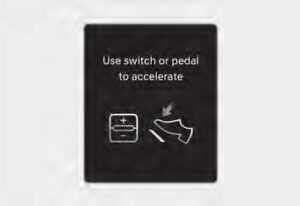 In traffic, your vehicle will stop if the vehicle ahead of you stops. Also, if the vehicle ahead of you starts moving, your vehicle will start as well. In addition, after the vehicle has stopped and a certain time has passed, the “Use switch or pedal to accelerate’ message will appear on the cluster. Depress the accelerator pedal or operate the + switch, – switch or I1 switch to start driving.
In traffic, your vehicle will stop if the vehicle ahead of you stops. Also, if the vehicle ahead of you starts moving, your vehicle will start as well. In addition, after the vehicle has stopped and a certain time has passed, the “Use switch or pedal to accelerate’ message will appear on the cluster. Depress the accelerator pedal or operate the + switch, – switch or I1 switch to start driving.
Warning road conditions ahead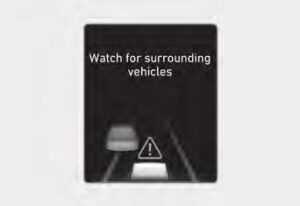
In the following situation, the ‘Watch for surrounding vehicles’ warning message will appear on the cluster, and an audible warning will sound to warn the driver of road conditions ahead.
- The vehicle in front disappears when Smart Cruise Control maintains the distance from the vehicle ahead while driving below a certain speed.
WARNING
Always pay attention to vehicles or objects that may suddenly appear in front of you, and if necessary, depress the brake pedal to reduce your driving speed in order to maintain a safe distance.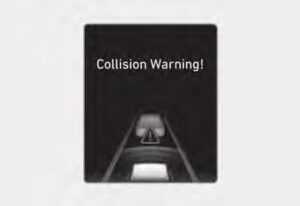
While Smart Cruise Control is operating, when the collision risk with the vehicle ahead is high, the ‘Collision Warning’ warning message will appear on the cluster, and an audible warning will sound to warn the driver. Always have your eyes on the road while driving, and if necessary, depress the brake pedal to reduce your driving speed in order to maintain a safe distance.
WARNING
In the following situations, Smart Cruise Control may not warn the driver of a collision.
- The distance from the front vehicle is near, or the vehicle speed of the front vehicle is faster or similar to your vehicle
- The speed of the front vehicle is very slow or is at a standstill
- The accelerator pedal is depressed right after Smart Cruise Control is turned on
Warning
Take the following precautions when using Smart Cruise Control:
- Smart Cruise Control does not substitute for proper and safe driving. It is the responsibility of the driver to always check the speed and distance to the vehicle ahead.
- Smart Cruise Control may not recognize unexpected and sudden situations or complex driving situations, so always pay attention to driving conditions and control your vehicle speed. Keep Smart Cruise Control off when the function is not in use to avoid inadvertently setting a speed.
- Do not open the door or leave the vehicle when Smart Cruise Control is operating, even if the vehicle is stopped.
- Always be aware of the selected speed and headway distance.
- Keep a safe distance according to road conditions and vehicle speed.
- If the headway distance is too close during high-speed driving, a serious collision may result.
- When maintaining distance from the vehicle ahead, if the front vehicle disappears, Smart Cruise Control may suddenly accelerate to the set speed. Always be aware of unexpected and sudden situations occurring.
- Vehicle speed may decrease on an upward slope and increase on a downward slope.
- Always be aware of situations such as when a vehicle cuts in suddenly.
- When you are towing a trailer or another vehicle, turn off Smart Cruise Control for safety reasons.
- Turn off Smart Cruise Control when your vehicle is being towed.
- Smart Cruise Control may not operate normally if interfered by strong electromagnetic waves.
- Smart Cruise Control may not detect an obstacle in front and lead to a collision. Always look ahead cautiously to prevent unexpected and sudden situations from occurring.
- A vehicle moving in front of you with a frequent lane change may cause a delay in Smart Cruise Control reaction or may cause the function to react to a vehicle actually in an adjacent lane. Always drive cautiously to prevent unexpected and sudden situations from occurring.
- Always be aware of the surroundings and drive safely, even though a warning message does not appear or an audible warning does not sound.
- If any other system’s warning message is displayed or a warning sound is generated, the Smart Cruise Control warning message may not be displayed and a warning sound may not be generated.
- You may not hear the warning sound of Forward Collision-Avoidance Assist if the surrounding is noisy.
- The vehicle manufacturer is not responsible for any traffic violations or accidents caused by the driver.
- Always set the vehicle speed under the speed limit in your country.
- Vehicle distance acceleration on reaction speed may change if the driver’s driving style changes.
CAUTION
- The vehicle must be driven sufficiently to reflect the actual driving style of the driver, such as inter-vehicle distance, acceleration and reaction speed.
- Based on Driving style does not reflect whether the driver has changed when determining the driver’s driving style.
- If you are driving in special conditions, such as snow, rain, fog or steep slopes, the vehicle may not be driven according to the driver’s driving style
Information
- Smart Cruise Control may not operate for 15 seconds after the vehicle is started or the front view camera or front radar is initialized.
- You may hear a sound when the brake is controlled by Smart Cruise Control.
2023 Hyundai Santa Fe Specs, Price, Features, Milage (Brochure)
Smart Cruise Control Malfunction and Limitations
Smart Cruise Control malfunction
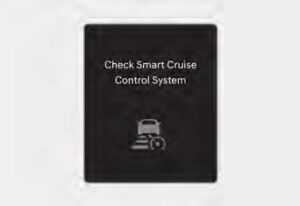
When Smart Cruise Control is not working properly, the ‘Check Smart Cruise Control system’ warning message will appear, and the warning light will illuminate on the cluster. Have the vehicle been inspected by an authorized HYUNDAI dealer?
Smart Cruise Control disabled

When the front radar cover or sensor IS Covered with snow, rain, or foreign material, it can reduce the detecting performance and temporarily limit or disable Smart Cruise Control. If this occurs the ‘Smart Cruise Control is disabled. Radar blocked’ warning message will appear for a certain period on the cluster. Smart Cruise Control will operate normally when snow, rain, or foreign material is removed.
WARNING
Even though the warning message does not appear on the cluster, Smart Cruise Control may not properly operate.
CAUTION
Smart Cruise Control may not properly operate in an area (for example, open terrain), where there is nothing to detect after turning ON the vehicle.
Limitations of Smart Cruise Control
Smart Cruise Control may not operate normally, or it may operate unexpectedly under the following circumstances:
- The detecting sensor or the surroundings are contaminated or damaged
- Washer fluid is continuously sprayed, or the wiper is on
- The camera lens is contaminated due to tinted, filmed or coated windshield, damaged glass, or stuck of foreign material (sticker, bug, etc.) on the glass
- Moisture is not removed or frozen on the windshield
- The field of view of the front view camera is obstructed by sun glare
- Street light or light from an oncoming vehicle is reflected on the wet road surface, such as a puddle on the road
- The temperature around the front view camera is high or low
- An object is placed on the dashboard
- The surrounding is very bright
- The surrounding is very dark, such as in a tunnel, etc.
- The brightness changes suddenly, for example when entering or exiting a tunnel
- The brightness outside is low, and the headlights are not on or are not bright
- Driving in heavy rain or snow, or thick fog
- Driving through steam, smoke or shadow
- Only part of the vehicle is detected
- The vehicle in front has no tail lights, tail lights are located unusually, etc.
- The brightness outside is low, and the tail lamps are not on or are not bright
- The rear of the front vehicle is small or does not look normal (for example, tilted, overturned, etc.)
- A vehicle suddenly cuts in front
- Your vehicle is being towed
- Driving through a tunnel or iron bridge
- Driving near areas containing metal substances, such as a construction zone, railroad, etc.
- An object reflecting off the front radar such as a guardrail, nearby vehicle, etc.
- The bumper around the front radar is impacted, damaged or the front radar is out of position
- The temperature around the front radar is high or low
- Driving in vast areas where there are few vehicles or structures (for example, desert, meadow, suburb, etc.)
- The vehicle in front is made of material that does not reflect on the front radar
- Driving near a highway (or motorway) interchange or tollgate
- Driving on a slippery surface due to snow, water puddles, ice, etc.
- Driving on a curved road
- The vehicle in front is detected late
- The vehicle in front is suddenly blocked by an obstacle
- The vehicle in front suddenly changes lane or suddenly reduces the speed
- The vehicle in front is bent out of shape
- With a vehicle in front, your vehicle changes lane at low speed
- The vehicle in front is covered with snow
- Unstable driving
- You are on a roundabout and the vehicle in front is not detected
- You are continuously driving in a circle
- Driving in a parking lot
- Driving through a construction area, unpaved road, partially paved road, uneven road, speed bumps, etc.
- Driving on an inclined road, curved road, etc.
- Driving through a roadside with trees or streetlights
- The adverse road conditions cause excessive vehicle vibrations while driving
- Your vehicle height is low or high due to heavy loads, abnormal tire pressure, etc.
- Driving through a narrow road where trees or grass are overgrown
- There is interference by electromagnetic waves, such as driving in an area with strong radio waves or electrical noise
- Driving on a curved road
 On curves, Smart Cruise Control may not detect a vehicle in the same lane, and may accelerate to the set speed. Also, vehicle speed may rapidly decrease when the vehicle ahead is detected suddenly.
On curves, Smart Cruise Control may not detect a vehicle in the same lane, and may accelerate to the set speed. Also, vehicle speed may rapidly decrease when the vehicle ahead is detected suddenly.
Select the appropriate set speed on curves and apply the brake pedal or accelerator pedal according to the road and driving conditions ahead.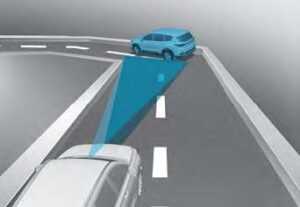 Your vehicle speed can be reduced due to a vehicle in the adjacent lane.
Your vehicle speed can be reduced due to a vehicle in the adjacent lane.
Apply the accelerator pedal and select the appropriate set speed. Check to be sure that the road conditions permit safe operation of the Smart Cruise Control. - Driving on an inclined road
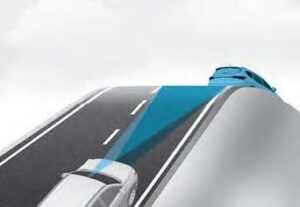 During uphill or downhill driving, the Smart Cruise Control may not detect a moving vehicle in your lane, and cause your vehicle to accelerate to the set speed. Also, vehicle speed will rapidly decrease when the vehicle ahead is detected suddenly.
During uphill or downhill driving, the Smart Cruise Control may not detect a moving vehicle in your lane, and cause your vehicle to accelerate to the set speed. Also, vehicle speed will rapidly decrease when the vehicle ahead is detected suddenly.
Select the appropriate set speed on inclines and apply the brake pedal or accelerator pedal according to the road and driving conditions ahead. - Changing lanes
 [A] : Your vehicle, [B] : Lane changing vehicle
[A] : Your vehicle, [B] : Lane changing vehicle
When a vehicle moves into your lane from an adjacent lane, it cannot be detected by the sensor until it is in the sensor’s detection range. Smart Cruise Control may not immediately detect the vehicle when the vehicle changes lanes abruptly. In this case, you must maintain a safe braking distance, and if necessary, depress the brake pedal to reduce your driving speed in order to maintain a safe distance. - Detecting vehicle
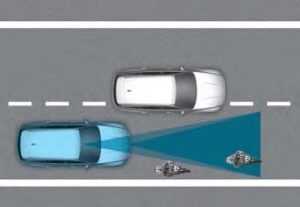 In the following cases, some vehicles in your lane cannot be detected by the sensor:
In the following cases, some vehicles in your lane cannot be detected by the sensor:
- Vehicles offset to one side
- Slow-moving vehicles or sudden-decelerating vehicles
- Oncoming vehicles
- Stopped vehicles
- Vehicles with small rear profiles, such as trailers
- Narrow vehicles, such as motorcycles or bicycles
- Special vehicles
- Animals and pedestrians
Adjust your vehicle speed by depressing the brake pedal according to the road and driving conditions ahead.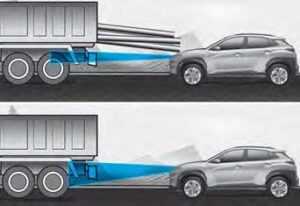 In the following cases, the vehicle in front cannot be detected by the sensor:
In the following cases, the vehicle in front cannot be detected by the sensor: - Vehicles with higher ground clearance or vehicles carrying loads that stick out of the back of the vehicle
- Vehicles that has the front lifted due to heavy loads
- You are steering your vehicle
- Driving on narrow or sharply curved roads
Adjust your vehicle speed by depressing the brake pedal according to the road and driving conditions ahead.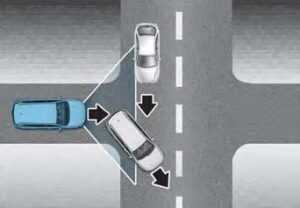
- When a vehicle ahead disappears at an intersection, your vehicle may accelerate.
Always pay attention to road and driving conditions while driving.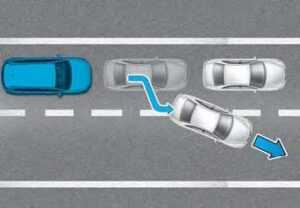
- When a vehicle in front of you merges out of the lane, Smart Cruise Control may not immediately detect the new vehicle that is now in front of you.
Always pay attention to road and driving conditions while driving.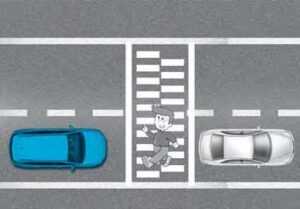
- Always look out for pedestrians when your vehicle is maintaining a distance with the vehicle ahead.
Information
This device complies with Part 15 of the FCC rules.
Operation is subject to the following three conditions:
- This device may not cause harmful interference, and
- This device must accept any interference received, including interference that may cause undesired operation.
- Changes or modifications not expressly approved by the party responsible for compliance could void the user’s authority to operate the device.
Information
Radiofrequency radiation exposure information:
This equipment complies with FCC radiation exposure limits set forth for an uncontrolled environment.
This equipment should be installed and operated with a minimum distance of 8 in. (20 cm) between the radiator (antenna) and your body.
This transmitter must not be co-located or operating in conjunction with any other antenna or transmitter.
FAQ
Cruise control is a system in a vehicle that allows the driver to set a specific speed for the vehicle to maintain automatically, without the need to continuously press the accelerator pedal.
When cruise control is engaged, the vehicle’s engine control system adjusts the throttle to maintain the preset speed set by the driver.
Cruise control helps reduce driver fatigue on long journeys, improves fuel efficiency by maintaining a constant speed, and can assist in adhering to speed limits.
Yes, the driver can override cruise control by either pressing the brake pedal or disengaging the cruise control system through the vehicle’s controls.
The availability of cruise control in specific trim levels or models may vary, so it’s advisable to check with Hyundai or a dealership for details on the 2023 Hyundai Kona-EV.
Smart Cruise Control, often known as Adaptive Cruise Control (ACC), is an advanced version of cruise control that can automatically adjust the vehicle’s speed based on the distance to the vehicle in front.
SCC uses sensors, such as radar and cameras, to detect the speed and position of vehicles in front. It can automatically reduce the vehicle’s speed and maintain a safe following distance.
SCC enhances safety by reducing the need for constant speed adjustments in traffic and helps prevent rear-end collisions by maintaining a safe following distance.
The availability of Smart Cruise Control in specific trim levels or models of the 2023 Hyundai Kona-EV may vary. You should consult Hyundai’s official website or a dealership for up-to-date information.
Some SCC systems are designed for stop-and-go traffic, allowing the vehicle to come to a complete stop and then resume following the vehicle in front when traffic starts moving again. However, this capability may vary by manufacturer and model.
Smart Cruise Control is often part of a comprehensive driver assistance package that may include features like lane keeping assist, lane departure warning, and more, depending on the vehicle and trim level.
Yes, most SCC systems allow the driver to customize the following distance, usually by selecting from different distance settings such as short, medium, or long.
SCC’s performance can be affected by adverse weather conditions, such as heavy rain or fog, which can reduce its effectiveness. Drivers should remain attentive and be prepared to take control of the vehicle if necessary.
Many electric vehicles, including the Hyundai Kona-EV, may offer Smart Cruise Control as an option, but its availability may vary by trim level and market.
Some vehicle manufacturers offer software updates to enhance the functionality of driver assistance systems like Smart Cruise Control. It’s advisable to check with Hyundai for any potential updates for the 2023 Kona-EV.
Useful Link
View Full User Guide: Hyundai Kona-EV 2023 User Guide
Download Manuals: https://owners.hyundaiusa.com/us/en/resources/manuals-warranties.html2023 Hyundai Santa Fe Specs, Price, Features, Milage (Brochure)

